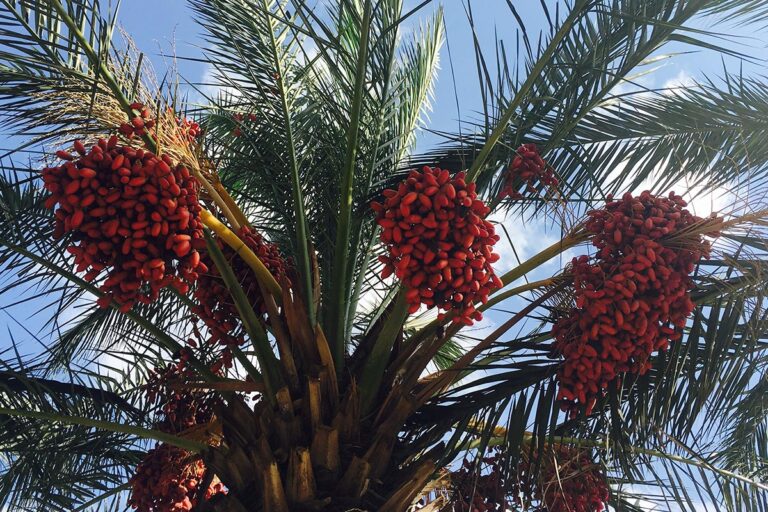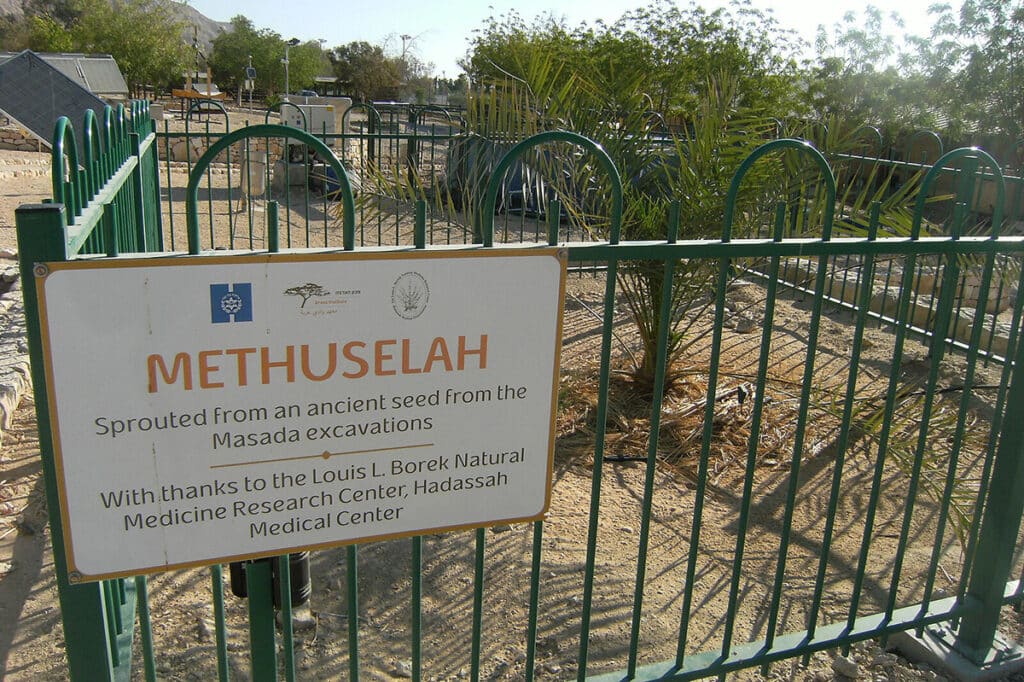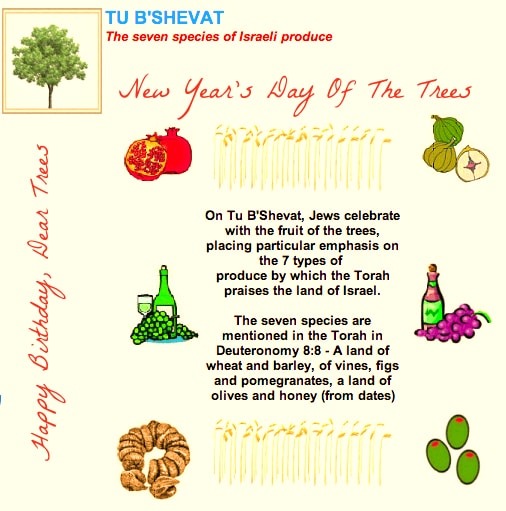
Not many species get the chance to come back from total extinction. Just ask the Dodo Bird (spoiler alert, you can’t, it’s gone for good). But the Judean date palm is one of the few exceptions. It experienced a miraculous revival when archeologists discovered a few 2,000-year-old seeds at Masada in the 1960s.
Masada, the last Jewish stronghold against the Romans, opened the door to bring back the tree. It turns out the Jewish rebels inside the fort had destroyed everything except their food stores to show the Romans they died of their own accord. The untouched provisions held a supply of dates that would allow the Judean Date Palm to make a comeback almost 2,000 years later.
@jewishunpacked What do 2,000 year old dates taste like? #Unpackedin75 #Israelat75 #israelidates
♬ original sound – Unpacked – Unpacked
Preserved in the arid environment since before 64 CE, the seeds were transported to Bar-Ilan University in Israel, where they remained dormant for 40 years. Historian medicine expert Dr. Sarah Sallon convinced the archeologists to plant the ancient seeds, and to the amazement of many, some of them sprouted — marking a literal breakthrough of Biblical proportions.
Let’s explore the story of how Sallon and a team of Israeli scientists brought these 2,000-year-old Judean date trees back to life.
The revival of Judean dates
In the late 1980s, while practicing medicine in India, Sallon encountered a personal health crisis. Modern antibiotics didn’t help her situation, prompting the doctor to delve into herbal remedies and historical cures. To Sallon’s astonishment, her condition improved through an ancient remedy. Inspired by this experience, she began researching medicinal herbs, both past and present, when she moved back to Israel.
This pursuit led her to the potential of the Judean date. She approached archeologists in Ramat Gan with a “crazy” idea. Utilizing a bottle warmer to nurture the seeds, Sallon and fellow researcher Elaine Solowey planted them in 2008. After just six weeks, the world witnessed Judean date palm seeds sprouting for the first time in centuries. Among the emerging greens, one palm — which they named “Methuselah” — grew into a sapling (the stage of a young tree).

However, a date palm can’t bear fruit on its own. Methuselah was a male, and with date palms, males provide the pollen necessary for reproduction, while females produce the flowers that bear fruit. To recreate the original Judean dates, Methuselah required a female mate.
Determined to bring the ancient fruit back to life, Sallon and her team sifted through the sands of the Judean Desert looking for more seeds. They found around 32 more ancient seeds — some at Masada and others at Qumran, the famed site of the Dead Sea Scrolls. With 32 ancient seeds in hand, the team decided to adopt a more rigorous, scientific approach.
Documenting every detail —color, size, weight — they immersed the seeds in water, adding fertilizers and hormones to aid germination. When planting time arrived, they chose one of Israel’s most distinctive agricultural centers: a kibbutz.
Out of the 32 seeds, six took root. The four male and two female saplings were named Judith, Hannah, Uriel, Jonah, Boaz and Adam.
In 2015, Methuselah pollinated Hannah, and in 2020, Hannah finally bore dates, taking about three years longer than common date trees to fruit. With this milestone, the legendary Judean date was reborn, heralding a revival centuries in the making.
“They thought I was mad!” Sallon said of the archeologists in 2020. “They didn’t think that this was even conceivable.”
Israel’s commitment to preserving its rich history made a comeback for these sweet snacks possible. The seeds’ incredible longevity is largely due to the unique environmental conditions around the Dead Sea region. The area’s thick atmosphere, enveloped in a mineral-rich haze helped protect the seeds from cosmic radiation. The area also boasts extremely dry conditions with minimal humidity, making it an ideal environment for preservation.
Since the trees began to bear fruit, researchers from around the world have descended on the formerly extinct trees for further research. They have since discovered that Judean farmers used more sophisticated agricultural techniques than those used in other parts of the ancient world.
The rise and fall of Judean dates
As far back as 500 BCE, dates were more than just a sweet treat for those in the land of Israel — they were a staple crop.
Given the desert environment, dates were the perfect superfood. They didn’t spoil easily, were packed with fiber, and were an astonishing 90% water when eaten fresh. They just required more water to grow than their modern counterparts, which is common with trees bearing larger fruit.
The Roman scribe Pliny the Elder wrote the dates had an “extremely sweet sort of wine-flavor like that of honey.”

Beyond their drier and ultra-sweet flavor, they also held economic and spiritual significance. In the Kabbalah, dates are associated with abundance and spiritual growth, connection to the Tree of Life, and the sweetness of divine wisdom.
In the Torah, 70 date palm trees symbolize the 70 “faces” of the Torah that are revealed to those who eat the tree’s fruit. In Kabbalah, many believe these “faces” are representative of unlocking the truths of mysticism because 70 is the value of the word sod or “secret” of Kabbalah in gematria, a system in which each Hebrew letter has a numerical value.
Dates are one of the seven species of Israel, the crops mentioned in the Torah as being important to the land. Other members of shivat haminim are grapes, olives, wheat, barley, pomegranates, and figs.

In more practical terms, exports of Judean dates stretched across the vast Roman Empire.
Throughout the ages, the Judean date was praised for its size, flavor and medicinal qualities, which is what caught Sallon’s attention in the first place.
Today, date palms are widely cultivated in Israel and the surrounding region, but the Judean date palm is conspicuously absent from the array, having vanished centuries ago. Its tragic decline was a result of multiple wars devastating the land and a period of global cooling between the 16th and 19th centuries known as “The Little Ice Age.”
The final blow came in the 14th century when the European Crusaders likely destroyed the world’s last standing Judean palm.
“They’re just historical ghosts,” Sallon told NPR. “Like the famous date plantations along the Dead Sea, 2,000 years ago — described by Pliny; described by Josephus, the first-century historian. They’re not there anymore. They just vanished!”
The revival of the Judean date palm stands as a testament to the resilience of nature and the ingenuity of human endeavor. Meticulous archaeological research and scientific innovation, the ancient Methuselah palm, once thought lost to the annals of history, has been brought back to life. Its resurrection not only offers a glimpse into the rich agricultural heritage of the region, but also inspires hope for the preservation and revitalization of other endangered species.
As this majestic tree takes root once again, it serves as a poignant reminder of the interconnectedness of past, present, and future, inviting us to cultivate a deeper appreciation for the wonders of the natural world and our role in safeguarding its treasures for generations to come.


